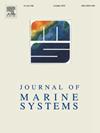鱼类和大型脊椎动物的中尺度组合是大陆架上底栖动物的证据
IF 2.5
3区 地球科学
Q2 GEOSCIENCES, MULTIDISCIPLINARY
引用次数: 0
摘要
尽管它们所代表的海洋表面比例相对较小,但大陆架生态系统是世界上最具生产力的生态系统之一。这些栖息地位于陆地和海洋环境的交界面,受到强烈的环境强迫,特别是海底环境强迫的影响。清楚地了解这些生境的空间分布,以及有关其相关群落的组成和功能的知识,对渔业管理和生态系统保护至关重要。在这里,我们使用了EVHOE年度水獭拖网调查(2008-2020)的数据来表征比斯开湾(法国)整个大陆架底栖生物群落的空间结构,并调查了这些模式的潜在环境驱动因素。研究了两种不同的生物成分:底栖大型脊椎动物和底栖鱼类。聚类分析从各站点的物种组成中鉴定出7个组合。每个组合都是根据其地理位置来命名的。我们发现了鱼类和大型脊椎动物不同组合的空间组织之间存在很强的相关性,为该陆架生态系统中底栖动物栖息地(底栖角)的大尺度空间结构提供了证据。影响最大的环境变量是底部温度、沉积物类型和初级生产。某些结构参数(如生物量)的格局揭示了生态功能可能的空间差异。例如,我们观察到从海岸到大陆架中心部分的生物量下降,随后在美洲大陆架边缘附近的生物量增加。这些模式反映了构成整个比斯开湾生态系统的主要大规模过程(河流输入与陆架断裂上升流)。比较分析表明,本研究所观察到的生物学特征和功能与其他欧洲大陆架相同。除了提高我们对底栖环境的认识外,这样的研究还可以促进在多种人为压力下快速变化的生态系统中基于生态系统的管理和海洋空间规划的改进。本文章由计算机程序翻译,如有差异,请以英文原文为准。
Mesoscale assemblages of fish and megainvertebrates as evidence of benthiscapes on continental shelves
Despite the relatively small proportion of ocean surface they represent, continental shelf ecosystems are among the most productive in the world. Located at the interface between terrestrial and marine environments, these habitats are structured by strong environmental forcings, especially on the sea bottom. A clear understanding of the spatial distribution of these habitats, along with knowledge on the composition and functioning of their associated communities, is essential for fisheries management and ecosystem conservation. Here, we used data from yearly EVHOE otter trawl surveys (2008–2020) to characterize the spatial structuration of benthic communities of the entire continental shelf of the Bay of Biscay (France), and to investigate the potential environmental drivers of these patterns. Two separate biological components were studied: epibenthic megainvertebrates and bentho-demersal fish. Clustering analyses identified seven assemblages from species composition of stations. Each assemblage was denominated according to its geographical location. We detected a strong correlation between the spatial organization of the different assemblages identified for fish and megainvertebrates, providing evidence for broad-scale spatial structuration of benthic habitats—benthiscapes—in this shelf ecosystem. The most influential environmental variables were identified as bottom temperature, sediment type, and primary production. Patterns in certain structural parameters, such as biomass, revealed possible spatial differences in ecological functioning. For example, we observed a drop in biomass from the coast to the central part of the shelf, followed by an increase in biomass near the edge of the Armorican shelf. These patterns reflect major large-scale processes (river inputs versus shelf-break upwelling) structuring the entire Bay of Biscay ecosystem. A comparative analysis revealed that the biological features and functioning observed in this study are shared with other European continental shelves. In addition to improving our knowledge of benthic environments, studies such as this one can promote improvements in ecosystem-based management and marine spatial planning of a fast-changing ecosystem under multiple anthropogenic stresses.
求助全文
通过发布文献求助,成功后即可免费获取论文全文。
去求助
来源期刊

Journal of Marine Systems
地学-地球科学综合
CiteScore
6.20
自引率
3.60%
发文量
81
审稿时长
6 months
期刊介绍:
The Journal of Marine Systems provides a medium for interdisciplinary exchange between physical, chemical and biological oceanographers and marine geologists. The journal welcomes original research papers and review articles. Preference will be given to interdisciplinary approaches to marine systems.
 求助内容:
求助内容: 应助结果提醒方式:
应助结果提醒方式:


